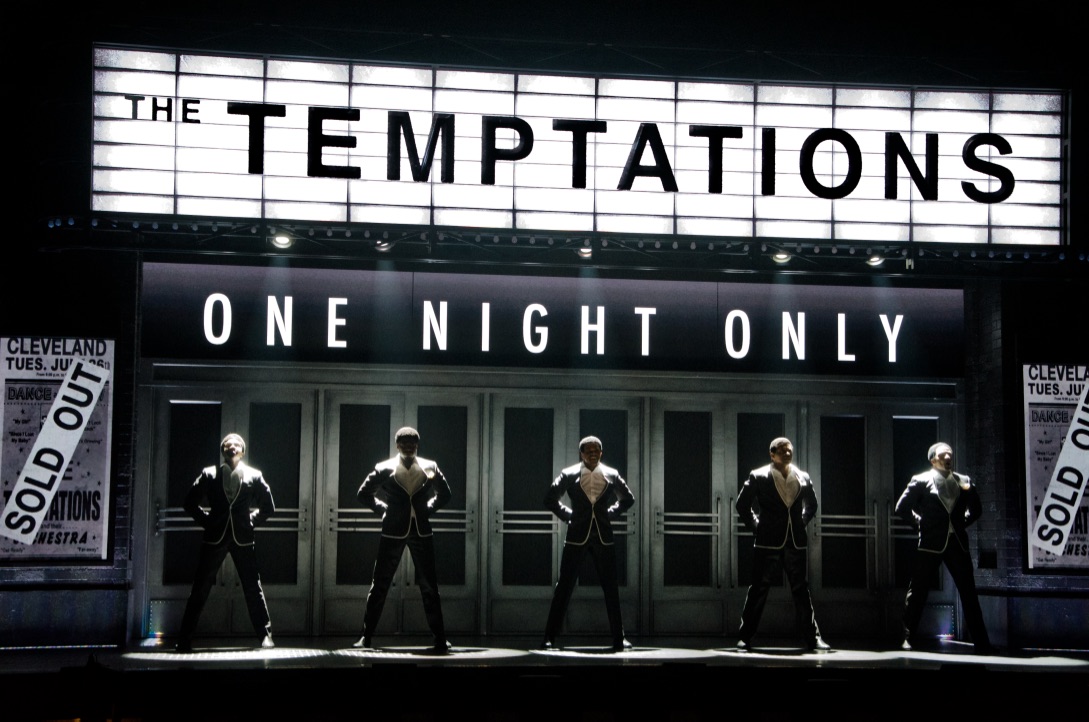You can achieve many successes in the music industry. You can climb to the top, you can enjoy the view from the top once you get there, but to be the top? There’s only group in the history of rhythm & blues that has been touted continually, through to this very moment, as the best group in the entire history of rhythm & blues: The Temptations didn’t climb to the top they became the top. In its pre-Broadway engagement, the brand new musical, Ain’t Too Proud: The Life and Times of The Temptations is blowing audiences away with its stellar songs, soul-stirring story, and stupendous singers, all embodying the life and times of the extraordinary group known as The Temptations. With Book by Dominique Morisseau, Music & Lyrics from The Legendary Motown Catalog, and based on the book entitled The Temptations by original Temptation himself Otis Williams, this sensational show has audiences all but on their feet, clapping, singing, cheering, and feeling every step of the incredible journey. Directed by Des McAnuff, with Musical Direction by Kenny Seymour and Choreography by Sergio Trujillo, this is the show-stopper of the season, the must-see summer show contained at The John F. Kennedy Center for the Performing Arts during the month of July.
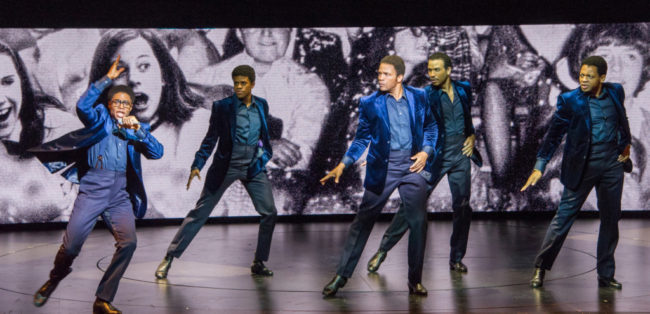
Well-scripted, Dominique Morisseau’s libretto follows an honest trajectory that delivers a stellar, true story alongside the musical hits that made The Temptations who they are. The narrative construct of Otis Williams is genuine; he comes from a place of authenticity and although exists as the guiding storyteller, everything he says comes from a place of truth whether its laced with energetic humor or weighted sorrow. In this production, Derrick Baskin carries the character of Otis Williams as if he were the originating member of The Temptations, wearing the story like a second skin, embracing the tale as if it comes from his own heart. Morisseau captures a divine story arc, giving you the whole group picture, not just the viewpoint of Otis Williams, but rather using the eyes of Williams as a focal lens for telling the tale. There is a cleanliness to the plot as it progresses, touching on the important milestones of the group without deviating too far down into any one individual’s track.
Fans of The Temptations and those unfamiliar with the music will love the show equally. All of the hits are there and featured prominently and in a manner that truly bonds them to the narrative story element. Ain’t Too Proud is more than a mere jukebox musical; it is a mesmerizing story with stellar music and dance moves all wrapped around one another to pull the audience into the rhythm & blues reality of their time. Musical Director and Arranger Kenny Seymour keeps the hits thrumming through the show’s duration, expertly aligning “Shout” with a montage of exciting events. The overall energy that flows through the piece, super-charged by Director Des McAnuff, has the audience stomping, clapping, singing, and cheering along through all of the upbeat numbers. That same energy is transformed into something phenomenally moving when the mood shifts and troubles, sorrows, and heartbreaking moments enter the narrative.
McAnuff takes the twists and turns of the tale and molds them beautifully into a musical masterpiece. Taking sharp turns around steep cliffs, McAnuff guides the vehicle of success through the long and winding road of the story that is The Temptations. Taking a high-energy scene over the riots in Detroit and stopping it hard and fast to deliver the news about the death of Martin Luther King Jr., McAnuff seamlessly pushes the energy from one moment to the next, never losing the core of the show’s drive in the process. While the beginning of the show blinks by so quickly— a brief glimpse into what motivated Otis Williams out of trouble and into music— McAnuff deftly manipulates the pacing so that it never drags, never loses the interest of the audience, and never falters even when songs and story arcs decelerate.
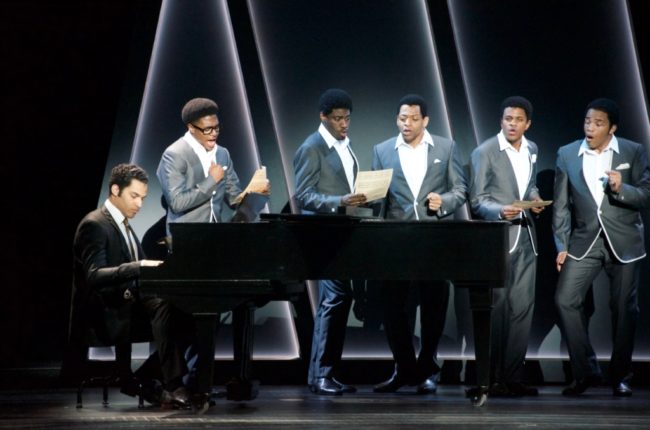
With a lively show atmosphere, Lighting Designer Howell Binkley keeps pace with the show’s high-octane existence, pumping out illuminating pulsations during the big showy dance numbers. Binkley cools down when necessary with mild scenic lighting to emphasize in a natural fashion the dramatic shift of the story. Scenic Designer Robert Brill works with Projection Designer Peter Nigrini to capture the literal movement of the times. The bus scene as The Temptations experience a horrific bout of violence in the south is striking in both its staging and its technical execution.
While “The Temps” themselves have flashy suits, compliments of Costume Designer Paul Tazewell, the extra glamour gets pumped into the show’s aesthetic palette by way of the dynamite dresses featured on Diana Ross and various other female singers who appear in cameo fashion throughout the production. Tazewell masterfully grasps the couture of the era, fashionably presenting the styles that made the well-loved and well-recognized look of The Temptations and other groups of the times.
When it comes to the mastery of the times, while the costumes, the visual setting, and even the performers in their fashion of speaking and moving, all manage to situate themselves well within the appropriate era, it’s Choreographer Sergio Trujillo who best understands the rhythm and movement of the 1960’s and 1970’s. Transitioning dance styles as the timeline races forward, Trujillo showcases the dancing roots through to the final radiant bloom of the physical moves that accompanied these extraordinary songs. Trujillo’s choreography, often completed by the five or so ‘Temptations’ actively on the stage during the up-tempo numbers, is sharp, crisp, and effective. The solo moves used for the more bombastically vivacious character, like Ruffin, are as impressive as the group routines which Trujillo designs. Ultimately supreme, Trujillo’s choreography is what makes the show a smashing success.
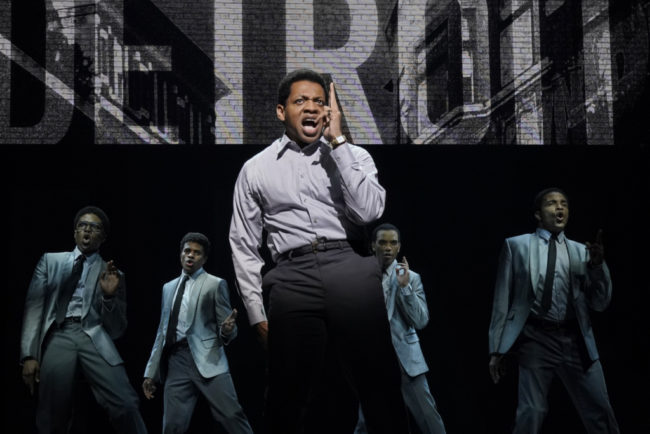
In a show full of men, four women hold their own in various roles throughout the production. Candice Marie Woods, Rashidra Scott, Nasia Thomas, and Taylor Symone Jackson (Diana Ross, Josephine, Tammi Terrell, and Johnnie Mae, respectively) each put a powerful punch of vocal panache onto the scene, whether it’s Jackson and her sassy blast when it comes to putting the young, green ‘Temps’ in their place or Scott who breaks all the hearts with her solo section of “If You Don’t Know Me By Now.” Scott, whose character recurs as the show advances, displays bitter maturity and finds her place in the fairytale of The Temptations, even if her portion of the tale is less than the hoped for happy ending.
With a smooth sound as rich a Midas and deep as the bottom of the ocean, Jawan M. Jackson tackles the role of bass Melvin “Blue” Franklin in a matter that can only be described as divine. Blending well with the rest of the group, Jackson’s soulful sound is a beautiful base upon which to build a pyramid of vocal perfection when it comes to this group sound that cast fabricates. At the opposite end of that sound spectrum, Jeremy Pope soars high with his tippy-top tenor sound, pushing into that heart-stopping falsetto sound from time to time, especially during numbers like “You’re My Everything.” Both Jackson and Pope have fantastic dance moves, and add a delectable variety to the various featured members of The Temptations.
The soul, the rhythm and reason, the baritone sound of the group, James Harkness takes on the likes of Paul Williams and does so with much success. Taking point during “Since I Lost My Baby”, the audience is treated to a fine solo sound in Harkness’ voice. A level-headed character, Harkness brings an honesty to the table that allows Paul Williams to find his footing and his place among the group.
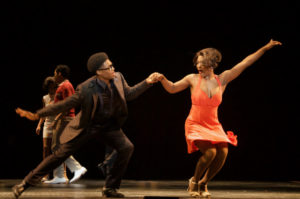
Nobody can sing like Ruffin (Ephraim Sykes); the truth spoken never sounded so good. Sykes embodies the larger-than-life nature of David Ruffin, from his humble beginning right through to his dramatic (and recurring) exits from the group. Sykes is a powerhouse force to be reckoned with between his stage presence, insane vocal talent, and unstoppable dance moves. There is a soul-purge pouring out of his voice during “I Wish it Would Rain.” While the entire group is deeply moving in this number, it’s Sykes who rises to the top with emotional fortitude. Outrageous, especially with the way he slides, splits, and struts all around the stage, Sykes’ secondary entrance to the group (near the top of the second act) is hilarious and while irritating to those in the group, adds a great level of humor to those watching all of his antics.
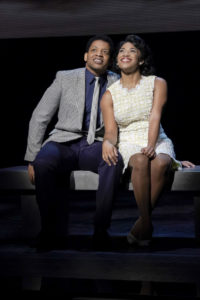
As mentioned the overall success of the libretto is owed in part to Derrick Baskin who truly embodies Otis Williams as if he were a character of his own original creation and not the most legendary member of rhythm & blues history. Baskin captures the heart, engages the mind, and frees the soul when he’s speaking, whether it’s with cheeky bits of humor or deep, pained sincerity. Baskin tells this story— tells THE story of The Temptations— like it is the only story in the world that ever mattered or ever will matter. The investment in his narrative conscious and convivial attitude toward the tale is second to none. With a sublime voice, dance moves that keep pace with the group, and an ability to transcend the depths of this story and pull its heart directly out for the audience to experience, Derrick Baskin is the top in this production.
Ain’t Too Proud is the summer sensation, no doubt soon to be the Broadway sensation of the season once it migrates from The Kennedy Center up to The Great White Way. Don’t miss your shot to be in the room where it’s happening; musical history is being uncovered, explored, and thoroughly enjoyed by all.
Running Time: 2 hours and 35 minutes with one intermission
Ain’t Too Proud plays through July 22, 2018 in The Eisenhower Theatre of The John F. Kennedy Center for the Performing Arts— 2700 F Street NW in Washington, DC. For tickets call the box office at (202) 467-4600 or purchase them online.

